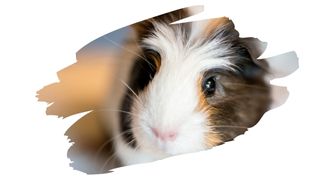Chipboard is cheap, easy to work with, and fairly durable. And those three reasons are why chipboard is used for budget-saving furniture.
However, as a manufactured wood, chipboard is as far away from natural solid wood as you can get. Especially since some of the chemicals used to produce it are fairly dangerous in their own right.
So, in this post we dive into what really lurks under the surface of chipboard. You will also learn why you should not use this manufactured material around chew-happy pets. And keep reading to discover why a special type of heat-treated lumber is the safest type of wood for guinea pigs.

This post may contain affiliate links to products that we receive a commission for (at no additional cost to you). Learn more here.
What Is Chipboard Actually Made From?
Chipboard (sometimes known as particleboard or Low Density Fiberboard) is a manufactured wood. So, what this means is that while it may comprise natural wood, it also contains a lot of synthetic material too.
In short, much like most other manufactured woods, chipboard is chock-full of chemicals.
Related Post: Is Plywood Safe To Use For Your Guinea Pigs Hideout?
Is Chipboard Dangerous To Use?
Not necessarily. Chipboard, once sealed, isn’t dangerous. However, the chemical glue contained inside chipboard is still harmful if it is in any way ingested.
Here’s the thing; chipboard glue often contains formaldehyde. This is typically as a formaldehyde-resin, such as urea-formaldehyde or melamine-formaldehyde. And it is the formaldehyde substance inside chipboard that’s dangerous.
Formaldehyde is no joke. If you ingest it, it can poison you. If it gets on your skin, it can burn you.
However, this substance is at its most lethal if you inhale its vapor.
Is Chipboard Formaldehyde Vapor Really That Worrisome?
In theory, no, it is not. Why? Well, because formaldehyde vapor only wafts off of chipboard if the glue inside of it is still off-gassing.
Off-gassing refers to the fumes (also known as VOC’s or Volatile Organic Compounds) that release off solvents, paints and glues.
Ever walked into a newly painted room only to be hit hard by a paint odor so strong that it makes your eyes water? Well, that smell is what we mean by off-gassing.
Now, with chipboard formaldehyde glues, they can continue to off-gas for months — up to two years — after manufacture.
However, once chipboard glue has finished off-gassing, it’s safe to have in your home. What’s more, responsible chipboard manufacturers will often have given chipboard time to dry out, well before they ship it out.
So, before chipboard even reaches your doorstep, it will have long since completed off-gassing.
But all of that simply means that formaldehyde vapor isn’t the actual concern with chipboard and your guinea pig. The genuine worry stems from the high chance of your guinea pig chewing into it.
Should I Be Worried About Having Chipboard Near My Guinea Pig?
Yes, you should. Especially if there’s any chance that your pet guinea pig may chew into chipboard.
Guinea pigs have strong teeth. And their teeth are more than capable of chewing through almost any type of wood sealant.
So if your guinea pigs nibble at chipboard, there’s a good chance they’ll chew into that chipboard glue. And that presents a risk to their health that is simply not worth taking.
Got It. So What Types Of Wood Are Safe To Use Around Guinea Pigs?
Natural untreated kiln dried wood should be your first (and pretty much only) choice. And you should not coat it with any chemical wood sealers or finishes either.
Also, the specific tree species the wood comes from matters, too. So, only use guinea pig safe wood types. For example, timber from select fruit-bearing trees, such as Apple wood, is safe for guinea pigs.
Related Post: Is Apple Wood Good Enough For Firewood?
And last, but not least, avoid using any kind of wood saturated by tree sap.
Tree sap is a natural resin secreted by trees. However, it is not a substance guinea pigs can safely ingest, so keep these wood types out of their way.
So, sap-saturated lumber from fir and pine trees should get crossed right off your list of wood choices.
Quick Side Note: You can use wood from sap-saturated lumber if that wood has been kiln dried. That’s because the process of kiln drying wood will evaporate these types of tree resins. However, you’re better off erring on the side of caution by sticking only to guinea pig safe lumber.
Wait A Second… What Exactly Do You Mean By Kiln Dried?
Well, when a tree gets logged, initially it still has a lot of moisture in it. And freshly cut lumber — sometimes referred to as green wood — has a moisture content of around 100%.
However, before we can use it for woodworking, we need to get that moisture content right down (ideally to below 19%). We do this by ‘seasoning’ wood.
Related Post: How To Season Wood (7 Tips)
Traditionally, seasoning wood involves leaving wood to air dry for around 6-12 months (depending on local climate).
But, kiln drying fast-tracks the whole seasoning process. Rather than leaving wood to dry, kiln drying involves baking wood inside a kiln oven for a few days.
Kiln drying not only dries wood out much, much faster, it also makes it more stable. Additionally, this heat-treatment process gets rid of any hidden bugs and insects, too.
Related Post: Kiln Dried Vs Air Dried Wood: Which Type Of Seasoned Lumber Is Right For Your Furniture?
To Wrap Up, Here Are The 3 Key Takeaways From This Post…
- 1). Chipboard is a manufactured wood. As a manufactured material, it comprises natural wood and synthetic glue.
- 2). Do not use chipboard if there’s any chance your guinea pig may chew into it.
- 3). Only use natural untreated kiln dried wood for your guinea pigs’ home. And steer clear of any chemically treated/sealed solid wood.
References:
Making the right home for your guinea pigs | RSPCA.org.uk
Long-term Impact of Formaldehyde and VOC Emissions from Wood-based Products on Indoor Environments | Sagepub.com



